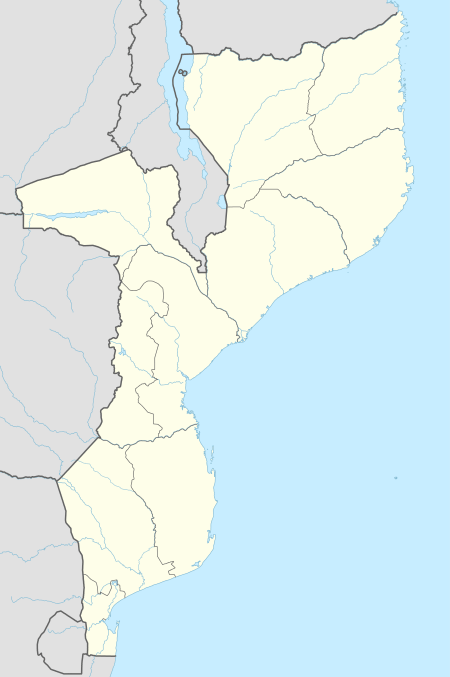Operation Eland
| Operation Eland | |||||||
|---|---|---|---|---|---|---|---|
| Part of the Rhodesian Bush War | |||||||
 Nyadzonya Operation Eland (Mozambique) | |||||||
| |||||||
| Belligerents | |||||||
|
|
| ||||||
| Commanders and leaders | |||||||
|
|
| ||||||
| Units involved | |||||||
| Unknown | |||||||
| Strength | |||||||
|
84 scouts[2] 4 armoured cars 7 trucks |
5,000 cadres[2] Unknown | ||||||
| Casualties and losses | |||||||
| 4 wounded |
1,028[2]-2,000 killed[3] 30 killed | ||||||
Operation Eland, also known as the Nyadzonya[lower-alpha 1] Raid, was a military operation carried out by operatives of the Rhodesian Selous Scouts at Nyadzonya in Mozambique on the 9th August 1976.[1] The Rhodesians claimed 300 ZANLA and 30 FAM (Armed Forces of Mozambique) soldiers were killed; documentation captured after the event suggested that 1,028 were killed.
Background
Throughout the summer of 1976, Rhodesia became aware of a major ZANLA staging and training camp located in Mozambique and identified as the Nyadzonya Base. This camp appeared to be the main insurgent and logistics base for operations conducted in the THRASHER operational area. Both aerial reconnaissance and captured guerrillas had confirmed that the camp contained a large hospital, and approximately 5,000 ZANLA personnel.
This constituted the largest center of insurgent activity discovered to this point in the war. As a result, a combined force was organised to include members of the RLI, RAC, SAS, Selous Scouts, and members selected from the Territorial Units.
The success of the “Flying-Column Attack” during the Mapai raid served as the basis for the tactics devised for a strike against the ZANLA forces at Nyadzonya. Once again, air support would be provided for serious medevacs on the objectives, and close air support would be available in the event of a dire emergency. The planning included a table model of the camp and its surroundings. Captured insurgents provided information concerning the defenses, positions of the armories, hospital, living quarters, the daily routine, and a general outline of the escape drills of the ZANLA insurgents. The “Flying-Column” consisted of 14 vehicles and 85 men. There were only two types of vehicles on the operation: 10 Unimog and 4 Ferret armoured cars. The transport vehicles were armed with a wide assortment of weapons: 20mm aircraft cannons, medium and light machine guns, and a captured Soviet 12.7 mm heavy machine gun. The men were dressed in captured Mozambique FRELIMO uniforms with their distinctive caps (the European members of the force wore black ski-masks). The vehicles were painted using the FRELIMO colors, and Rhodesian Intelligence had provided genuine FRELIMO registration numbers for the vehicle license plates.
Operation
On the 5th August 1976, a group of 60 ZANLA guerrillas entered Rhodesia from Mozambique and attacked a military base at Ruda, near Umtali. Four days later, guerrillas killed four soldiers in a mortar attack, and another died in a follow-up operation. The local white population demanded that action be taken.[2]
Operation Eland was hatched, and involved a cross-border raid by 84 Selous Scouts under Captain Rob Warraker against a concentration of guerrillas located at a training camp on the Nyadzonya River, 40 kilometres (25 mi) away in Mozambique. The attacking column consisted of four Ferret armoured cars and seven armoured Unimogs, two of which were armed with 20mm Hispano cannons scavenged from obsolete aircraft. The vehicles were disguised to make them look like they belonged to FRELIMO, while the men wore uniforms to match.[2] Amongst the soldiers was a turned former ZANLA commander by the name of Morrison Nyathi, who led the attackers to the camp.[4]
The attacking party was able to bluff its way past the gate guards and drive into the very heart of the camp. Nyathi blew a whistle, which was the emergency signal for the guerrillas to muster on the parade ground;[4] the vehicles were swarmed by thousands of guerrillas before the Rhodesians opened fire at point-blank range. Carnage ensued, with hundreds being shot, or drowning in the nearby river in their attempt to escape. ZANLA documents captured after the raid indicated that 1,028 of their number had been killed, a figure considerably higher than the 300 initially claimed by the Rhodesians.
The bridge over the Pungwe River was a key strategic point that the assault team had to fight their way through on their return journey to Rhodesia. The bridge was successfully assaulted, and then charges laid under enemy fire to destroy it, and thereby to cover the escape.
Aftermath
The South African government withdrew military support that was being provided covertly through Operation Polo. ZANLA claimed that the base was a refugee camp, and that the assault was the worst atrocity of the war.[2] However, captured ZANLA documents revealed that the people killed in the raid were either trained guerrillas or were undergoing guerrilla instruction and training.[5]Also after the war ZANLA members admitted that the camp had not been a refugee camp and had been a military base.
References
- 1 2 3 Smith, Ian (1997). The Great Betrayal. London: Blake Publishing Ltd. pp. 195–196. ISBN 1-85782-176-9.
- 1 2 3 4 5 6 7 8 9 Moorcraft, Paul L.; McLaughlin, Peter (April 2008) [1982]. The Rhodesian War: A Military History. Barnsley: Pen and Sword Books. ISBN 978-1-84415-694-8.
- 1 2 Peter J.H. Petter-Bowyer. Winds of Destruction: The Autobiography of a Rhodesian Combat Pilot (2005 ed.). 30°. pp. 278–279. ISBN 0-9584890-3-3.
- 1 2 Manyame-Tazarurwa, Kalister Christin (2011). Health Impact of Participation in the Liberation Struggle of Zimbabwe by Zanla Women Ex-combatants in the Zanla Operational Areas. AuthorHouse. ISBN 1467891975.
- ↑ Stiff, Peter; Reid-Daly, Lt. Col. Ron (1982). Selous Scouts: Top Secret War. Alberton (South Africa): Galago. pp. 397–406.
Notes
- ↑ Also spelt "Nyadzonia" in some texts